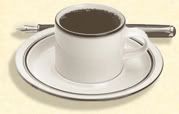Ways of Seeing...
On the fourth level, they had put up this huge digi-art image showing a Pakistani crowd looking upwards, presumably at a cricket ball. Nothing worthy of comment at first sight. Infact I was rather bemused when I noticed one man giving it detailed attention - so I went forward myself to see what had caught his attention and then the light dawned on me! The entire picture was composed of thousands of tiny pixelated images of scenes from Bollywood films! Now that's how to make a statement with style! :-)
The series of images that truly snagged my attention were on the top-most storey. Radical, they were all feminist in nature and served the purpose of making you sit up in your seat and take notice of each one of them. At times like this, I almost wish NGMA was smaller, because by the time I reach the top storey I'm beginning to feel glutted by artistic impressions. Anyway, digressions apart, flanked by two panels with actual henna aplique work, were three digi-art works, which according to me were the most radical and interesting works. Like the earlier digi-art work that I mentioned, at first sight, this was also a banal portrayal of women in purdah. But on closer observation, you notice that the image is made up of tiny pornographic images, mostly of white women. Not very difficult to interpret, is it? Do what you want, hide her in purdah, lock her up at home, segregate her into an exclusively female area, but the male gaze is still there to strip her naked, inavde her private space, assualt her mentally, physically and sexually.
For a long time after, I was mulling over some of these pieces, in particular these three images and the painting framed by the Jharokha, and came back repeatedly to John Berger's landmark essay "The Female Nude" featured in his book "Ways of Seeing." Berger states that the social presence of men and women differ - while the male presence is contingent on the power he embodies and projects on the world exterior to him, the female presence is expressed by her own attitude towards herself, her body, her appearance, of which dictates what can and can not be done to her. To born a woman, says Berger, is to have been born within an allotted and confined space into the keeping of men. A woman is forced to continually watch herself. She thus becomes her own surveyor, even while she is the one surveyed/object of survey under the male gaze. It works this way - how a man perceives a woman's presence dictates how she will be treated. With the internalisation of these norms, the woman looks upon herself with a similar gaze so as to fashion herself and demonstrate how she she would like to be treated.
Berger then makes, what is perhaps, the fundamental statement of the essay: "Men act and women appear. Men look at women. Women watch themselves being looked at...The surveyor of woman in herself is male: the surveyed female." (The Jharokha? Also think of the women in purdah.) "Thus she turns herself into an object - and most particularly an object of vision : a sight."
Berger, uses the examples of several pieces of art and examples from advertisements to underline the fact that at all times, the woman (subject of art/advertisements) is aware of being seen by the spectator. As he puts it, "She is not naked as she is. She is naked as the spectator sees her." Nakedness in these works is not an expression of the woman's feelings, but more of a sign of her own submission to the owner/viewer's demands and expectations.(Connotation of the pornographic images?) He then differentiates between the naked and the nude. "Naked is to be oneself. To be nude is to be seen naked by others and not recognised for oneself. A naked body has to become an object in order to be a nude...Nakedness reveals itself. Nudity is placed on display."
To come back to the point, the viewer (voyeur, if you please) has been assumed to be the male ever since the Classics first depicted nudes and this tradition has been carried forward into the modern media of advertising, journalism and television. The end result? Women are depicted to please the male gaze and this has been embedded so deeply in our culture that it structures the very consciousness of women, and women readily do to themselves what men would do to them. Think about it....




0 Comments:
Post a Comment
<< Front Page